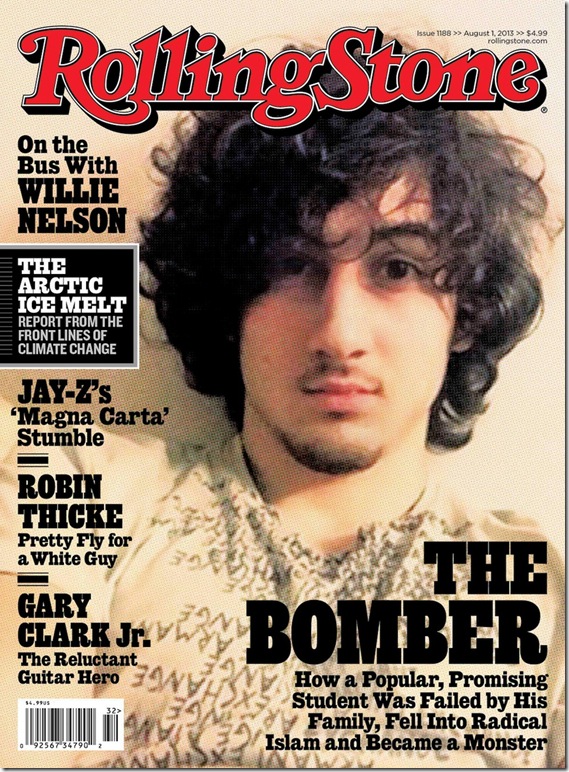By Myles Ludwig
I happened to be thinking about semiotics this week — what signs mean, stand for, whether they’re iconic or indexical or just plain cigars — when the new Rolling Stone magazine cover slams into the bandwidth with the angry splat of a Siberian meteor.
This must be some kind of cosmic synchronicity, I thought. Here I am trying to get my mind around a rather abstruse academic concept — one of those, which when explained simply in civilian language, always seems clearly obvious — when this monstrous nugget of the role of the universe drops in my lap.
Too good to be true.
The magazine’s cover shot lit up the bandwidth. Everybody had an opinion about the appropriateness of the moody, romanticized, glam selfie of the notorious kid from Dagestan staring into the middle distance on the cover. The opinions ranged from tsk, tsk to WTF. Media spouters donned their custom-tailored self-righteous Brionis and marveled at the unmitigated, but not unmediated, gall.
Social media was ablaze, they reported. A four-alarm fire of tweets. Advertisers shivered, but sucked it up. Retailers announced altruistically, in the spirit of political correctness and social sensitivities, that they were proudly forgoing the minuscule profits on the single copies of the magazines they sell (only about 75,000 copies of RS’s total 1.4 million) and refuse to display the issue.
Shades of Chick-fil-A.
It was as if the music magazine — known for stirring the culture pot more than once — had put a soft-focus shot of Adolf Eichmann or a strung-up Saddam Hussein on its cover. Or the latest nutso bogeyman, Bashar al-Assad.
The Rolling Stone of late has been reaching for relevancy among the digital natives who find the thought of paper disgusting. (I mean, Johnny Tonto!) This issue’s very weird combination of the Boston B-boy, and coverlines touting stories story smoking up the rails with Willie Nelson, and whether or not Jay-Z has lost his mojo in married life, trading his street creds for a romp with Justin Timberlake and a good seat at the Charlie Rose table of moguldom, demonstrates the seriousness of the struggle to stand out amid the current garbage heap of magazines. And the problems of print in general.
Frankly, I’m really surprised they didn’t put a cool shot of Trayvon Martin in a Juicy hoodie snogging the girls from Pussy Riot on the cover.
Now I admit I am as guilty as any highly knowledgeable media savant — the Al Rokers, Hoda Kotbs, Kathie Lee Giffords, et al. — when it comes to leaping with Schadenfreude all over the place when it comes to media-on-media killing — something like black-on-black crime or blue-on-green shootings in Afghanistan, only more abstract. This not-so-new phenomenon in our mediaverse is further empirical evidence for my developing-but-inexorable crawl towards a hypothesis that in our current atmosphere of quick-as-a-wink self-cannibalization, the media is quite willing, quite delighted in fact, to eat its young.
These are times when the word “subtext” pops up as part of the rhetorical vocabulary in a taco sauce TV commercial; when Kathie Lee Gifford, the undisputed, dowager Princess of Squareville, wonders about the miracles of Photoshop, soon to become the Netflx of picture-fixing; when the avuncular Al Roker wonders what apocalypse redux is coming down the pike. It’s a sign of the times.
If Derrida were still alive, I wouldn’t be surprised to see him kibitzing with lovely Mary Louise Parker on the Jimmy Kimmel show, debating kabbalah with Madonna on Jimmy Fallon, or doing drive-thru webstands with Jerry Seinfeld, the existentialist comedian.
Rolling Stone is no stranger to controversy. It raised the freak flag of my generation and sometimes lowered it to half-mast. Jan Wenner gave birth to the magazine in San Francisco many years ago to cover rock and roll when it was emerging from the mosh pit of devil’s music and American Bandstand sock hops. The magazine kept going. It fried Hunter Thompson, published Tom Wolfe and shot Annie Leibovitz out of its glitter cannon into the photo firmament when she was still a kid.
Rolling Stone became a popcult paragon — and parasite.
The dreamy Tsarnaev portrait is likely to bring a rush of tween girls who love murderers out of the closet, the kinds of girls who think Charlie Manson, Ted Bundy and O.J. Simpson are oh-so-cute. Marriage proposals will undoubtedly be forthcoming.
Already, Boston Magazine has countered with a batch of unofficially released pictures of the bloody bomb-boy climbing out of his boat-hole. What will Yachting and Motor Boating magazine do?
Like Anthony Soprano said, “Every day is a gift, but does it have to be a pair of socks?”
Myles Ludwig is a media savant living in Lake Worth.
